In the Spring of even-numbered years, Dane County elects Supervisors for two years. All 37 of them. Does that matter for public transportation? Not so far, but things could and should change. Almost half the seats on the County Board will be occupied by someone new.
Successful candidates will help shepherd the development of the fastest growing county in the state. Doing so intelligently means that we cannot just continue to do what was done in the past. That includes having no involvement in mass transit. Rather, a recent survey of residents throughout the county found that they want the county to “obtain a regional high-capacity multi-modal transit system that connects Madison and surrounding communities and increases people's access to jobs, services, and resources.” Current state law makes it difficult to achieve that goal, but there is still a lot that can be done on the local level to move us in the correct direction.
Unfortunately, as a recent piece in the Isthmus opined, the importance of county government tends to go unrecognized by many. The office of County Executive did not even exist until 1973, and a mere five of the 37 County Supervisor seats are being contested this year. Only one of those seats is for a Madison district –- the one traditionally representative of the ever-changing UW-Madison student body (District 5).
Reinforcing that view, a recent and rather dismissive editorial in the Wisconsin State Journal showed a lack of awareness of the amount of county resources devoted to public works and transportation. It demonstrated no awareness of a potential or desire for county government to become a major player in our transportation scene. In fact, one can wonder whether the views espoused in that piece were more a reflection of a poorly informed past than a leader of a well-informed vision for the future.
Given such lack of appreciation, it needs to be emphasized that Dane County now has over half a million people and wields an operating budget (2020) of almost $600 Million. Its Board of Supervisors is the legislative body that decides on the size and composition of that hefty budget. One of the Board's seven standing committees is "Public Works and Transportation." (The word "transportation" only being added to "public works" fairly recently during Kathleen Falk's tenure.) And 10% of its operating budget goes to "public works." In the future, can some of that 10% be for "transportation?" What are the prospects with the current set of Supervisor candidates?
Before every election, the League of Women Voters of Dane County compiles a candidates’ answers booklet that is also uploaded onto their website. Not only does it post short answers to a set of four questions, it also lists candidate websites or Facebook pages that provide further information. The League itself asked two questions directly relevant to public transit:
- What significant environmental issues face Dane County, and what should the County Board do about them?
- What is an important social service/criminal justice issue facing Dane County that you hope to address by serving on the County Board?
This piece surveys whether candidates mention "transportation" an environmental or social issue of relevance to their participation in county government.
Transportation as Part of a Significant Environmental Issue Facing Dane County
Of the 43 candidates running for office, only four clearly mentioned transportation when discussing significant environmental issues facing the county: Chawla, Bayrd, Andrae and Bare. For instance, Chawla's website reads in part: “The science is clear: global warming is the existential crisis of our time. We need a broad transportation policy, beyond just the automobile, that focuses on connecting all our communities in Dane County.”
In the League's document itself Bayrd replies to the question about environmental issues by saying: “Reduce fossil fuel use by supporting mass transit and retrofitting / developing green buildings.” Andrae's reply there includes: “We should also continue to shift to alternative modes of transportation, including use of bike trails and public transit.” Finally, Bare's reply in the League's document is: “As a quickly developing County, we must incentivize sustainable and environmentally-friendly transportation infrastructure ....”
Other candidates mention important issues as well of course such as flooding, water quality, runoff and lake level. Oftentimes, such issues are linked to the more general issue of climate change. There is no question that those are important environmental issues in an area rife with lakes and marshland. Veldran (District 7) even mentions the production of CNG from county landfill. But a common blind spot seems to be that per capita carbon emissions in the Madison area keeps increasing every year, in large part due to an increase in vehicle miles traveled (Emissions Report: Cars Are Still Our Biggest Problem). Tackling flood-causing climate change needs to include a serious effort to shift us away from our current over-reliance on the automobile.
Transportation as Part of an Important Social Service/Criminal Justice Issue Facing Dane County
Of the 43 candidates, only seven clearly mentioned transportation when discussing significant social issues facing the county: Wegleitner, Chwala, Bayrd, Andrae, Gray and Doolan. But that assessment would seem even less informative than the one regarding the environment because one derives the sense that others would approve of greater county financing of non-automobile transportation modes IF someone else took the lead in proposing something.
Wegleitner mentions fare-free transit on her website. Chwala states that “transportation investments must use an equity lens” on his. Bayrd mentions the need for transportation to help empower community voices in her answer to the League. Andrae mentions improving access to services. Gray states on his website: “I will advocate for investment in our infrastructure and champion opportunities for public transit, a necessity as Dane County’s population continues to grow dramatically.” And to the League again, Doolan also mentions the importance of access, perhaps inadvertently also emphasizing transportation's importance in both urban and rural areas: “Access to services is difficult at best for rural residents. Infrastructure issues, reliable transportation needs ....”
Fuzzier responses warrant mentioning. In relating a little pertinent background, Elizabeth Doyle (District 1) mentions that she had some work experience in transportation. What kind of transportation is left unclear although she shows a picture of someone riding the bus on her Facebook page. Alex Joers of District 9 explicitly cites public transportation as a County Board issue. And given his mention of transportation's importance to county development in reply to a question about environmental issues, one might easily surmise that Mike Bare (District 32) chose not to redundantly mention public transportation again when speaking about social services/criminal justice issues.
In conclusion, are we at a turning point regarding county involvement in non-auto transportation? Some years ago when Robin Schmidt was the supervisor for Monona (District 24) and Chair of the Public Works and Transportation Committee, she had a Transit Subcommittee that held listening sessions throughout the county. Based on the findings, she was able to get an amendment into the 2016 Capital Budget for $1.5 Million. Not only was that money never spent but the county has since added $28 to a Vehicle Registration Fee, revenue from which it spends liberally on roads while allocating nothing for public transit. Will such subversion continue, or will Dane County now have the leadership it needs to move us toward a high-capacity multi-modal transit system?




